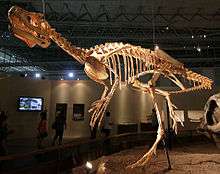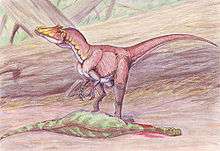Deltadromeus
| Deltadromeus Temporal range: Late Cretaceous, 95 Ma | |
|---|---|
 | |
| Mounted skeleton cast with reconstructed skull | |
| Scientific classification | |
| Kingdom: | Animalia |
| Phylum: | Chordata |
| Class: | Reptilia |
| Clade: | Dinosauria |
| Order: | Saurischia |
| Suborder: | Theropoda |
| Family: | †Neovenatoridae |
| Genus: | †Deltadromeus Sereno et al., 1996 |
| Species: | †D. agilis |
| Binomial name | |
| Deltadromeus agilis Sereno et al., 1996 | |
Deltadromeus (meaning "delta runner") is a genus of large theropod dinosaur from Northern Africa. It had long, unusually slender hind limbs for its size, suggesting that it was a swift runner. The skull is not known. One fossil specimen of a single species (D. agilis, or "agile delta runner") has been described, found in the Kem Kem Beds, which date to the mid Cretaceous Period (mid Cenomanian age), about 95 million years ago. It may be a junior synonym of the contemporary Bahariasaurus.[1] Often thought to be a ceratosaurian, the discovery of the theropod Gualicho shinyae indicates it is likely a sister taxon to the South American predator.[2]
Description

The fairly complete holotype skeleton of Deltadromeus agilis (museum catalogue number SGM-Din2) measured an estimated 8 m (26.24 ft) long.[3]
A number of specimens (catalogued under IPHG 1912 VIII) were originally considered by Ernst Stromer to be conspecific with Bahariasaurus,[4] but were referred to Deltadromeus by Paul Sereno in 1996.[5] They were thought to come from a much larger individual, with a femur (upper leg bone) length of 1.22 meters, compared to 0.74 meter femur of the holotype.[5] However, the referral of the coracoid, pubes, and hindlimb material catalogued under IPHG 1912 VIII to Deltadromeus has been questioned because the remains came from different horizons and localities in the Bahariya Formation, and actually exhibit notable differences from the holotype of Deltadromeus.[6]
Deltadromeus skeletons have been found in the same formations as those of the giant theropods Carcharodontosaurus, Spinosaurus, and Bahariasaurus, which may be synonymous with Deltadromeus. No skull material has been found for either Deltadromeus or Bahariasaurus, and though carnivore teeth labelled as "Deltadromeus" are commonly sold in rock shops, there is no way of knowing if they actually come from this animal.[1]
Deltadromeus is thought to have weighted up to 2 metric tons.[7]
Classification
.jpg)
Deltadromeus was originally described as a large coelurosaur, but more recent studies suggest it was actually a ceratosaur, though exactly what type of ceratosaur remains unknown. One 2003 study suggested it was a member of the Noasauridae,[8] though others have found it to be more primitive, possibly related to the primitive ceratosaurs Elaphrosaurus and Limusaurus.[9][10] A more comprehensive study of noasaurid relationships published in 2016 found that both of these interpretations were essentially correct, with Deltadromeus, Limusaurus, and Elaphrosaurus all found to be within the Noasauridae.[11]
The cladogram below follows a 2016 analysis by Oliver Rauhut, and Matthew Carrano.[11]
| Abelisauroidea |
| ||||||||||||||||||||||||||||||||||||||||||
| |
Different analyses have not found Deltadromeus to be a ceratosaur. An analysis of Gualicho, a South American theropod belonging to the allosauroid family Neovenatoridae, finds Deltadromeus to be Gualicho's probable sister taxon.[12] In an analysis of Aoniraptor, which may be the same animal as Gualicho, Deltadromeus was found along with Aoniraptor and Bahariasaurus to probably form a still poorly known clade of megaraptoran tyrannosauroids different from the Megaraptoridae.[13]
The cladogram below follows a 2016 analysis by Sebastián Apesteguía, Nathan D. Smith, Rubén Juarez Valieri, and Peter J. Makovicky.[12]
| Allosauroidea |
| ||||||||||||||||||||||||||||||||||||||||||
| |
References
- 1 2 Holtz, Thomas R. Jr. (2008) Dinosaurs: The Most Complete, Up-to-Date Encyclopedia for Dinosaur Lovers of All Ages Supplementary Information
- ↑ https://www.sciencedaily.com/releases/2016/07/160714152519.htm
- ↑ Seebacher, F. (2001). "A new method to calculate allometric length-mass relationships of dinosaurs." Journal of Vertebrate Paleontology, 21(1): 51–60.
- ↑ Stromer (1934). "Ergebnisse der Forschungsreisen Prof. E. Stromers in den Wüsten Ägyptens." II. Wirbeltierreste der Baharije-Stufe (unterstes Cenoman). 13. Dinosauria. Abh. Bayer. Akad. Wiss., Math.-Nat. Abt., (n. s.) 22 1-79, 3 pls.
- 1 2 Sereno, Dutheil, Iarochene, Larsson, Lyon, Magwene, Sidor, Varricchio and Wilson (1996). "Predatory Dinosaurs from the Sahara and Late Cretaceous Faunal Differentiation." Science, 272(5264): 986-991.
- ↑ Mortimer, Mickey (September 17, 2014). "No giant Egyptian Deltadromeus". The Theropod Database Blog.
- ↑ https://sites.google.com/site/paleofilescom/deltadromeus
- ↑ Wilson, Sereno, Srivastava, Bhatt, Khosla and Sahni. (2003). "A new abelisaurid (Dinosauria, Theropoda) from the Lameta Formation (Cretaceous, Maastrichtian) of India." Contr. Mus. Palaeont. Univ. Mich., 31: 1-42.
- ↑ Carrano & Sampson (2008). "The Phylogeny of Ceratosauria (Dinosauria: Theropoda)". JSysPaleo 6: 183-236
- ↑ Xu, X., Clark, J.M., Mo, J., Choiniere, J., Forster, C.A., Erickson, G.M., Hone, D.W.E., Sullivan, C., Eberth, D.A., Nesbitt, S., Zhao, Q., Hernandez, R., Jia, C.-K., Han, F.-L., and Guo, Y. (2009). "A Jurassic ceratosaur from China helps clarify avian digital homologies." Nature, 459(18): 940–944. doi:10.1038/nature08124
- 1 2 Rauhut, O.W.M., and Carrano, M.T. (2016). The theropod dinosaur Elaphrosaurus bambergi Janensch, 1920, from the Late Jurassic of Tendaguru, Tanzania. Zoological Journal of the Linnean Society, (advance online publication) doi:10.1111/zoj.12425
- 1 2 Sebastián Apesteguía; Nathan D. Smith; Rubén Juárez Valieri; Peter J. Makovicky (2016). "An Unusual New Theropod with a Didactyl Manus from the Upper Cretaceous of Patagonia, Argentina". PLoS ONE. 11 (7): e0157793. doi:10.1371/journal.pone.0157793.
- ↑ Matías J. Motta, Alexis M. Aranciaga Rolando, Sebastián Rozadilla, Federico E. Agnolín, Nicolás R. Chimento, Federico Brissón Egli, and Fernando E. Novas (2016). "New theropod fauna from the Upper Cretaceous (Huincul Formation) of northwestern Patagonia, Argentina". New Mexico Museum of Natural History and Science Bulletin. 71: 231–253.
